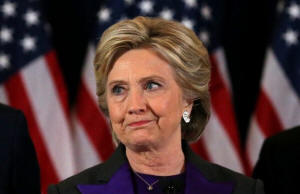|
How Hillary Clinton's white voters melted
away
 Send a link to a friend
Send a link to a friend
 [November 11, 2016]
By Peter Eisler [November 11, 2016]
By Peter Eisler
BETHLEHEM, Pennsylvania (Reuters) - The
unraveling of the coalition that was supposed to carry Hillary Clinton
to the White House had a lot to do with voters like Jim McAndrew in
counties like Northampton, Pennsylvania.
McAndrew, 69, a retired steel worker, voted Democrat in every
presidential election for half a century. This year he stayed home. And
Northampton County, a heavily white, heavily Democratic, largely working
class area that backed President Barack Obama in 2008 and 2012, went for
Donald Trump, a Republican.
McAndrew, who voted for Obama in the two previous races, was intrigued
by Trump, but decided eventually that “all he does is insult everybody
... women, black people, white people, rich, poor. He’s an idiot.” He
considered Clinton, but was concerned by the scandal over her handling
of classified material on a private email server as secretary of state.
“I hated both of them, so I just said, ‘the hell with it,’” McAndrew
said. His wife, also a life-long Democrat, went to the polls without him
- and voted Republican.
“First time ever," he said.
Trump’s ability to flip reliably Democratic counties like Northampton
helped drive his victory in the presidential election this week. It was
critical to his win in Pennsylvania and other Rust Belt states, a
bulwark in the Democrats’ electoral strategy for winning the White
House, and it helped fuel his victories in critical swing states, such
as Florida and North Carolina.

It’s not that Trump’s economic populism and "America First" messages
generated widespread enthusiasm; he won some of those counties with far
fewer votes than Mitt Romney captured as the Republican nominee in 2012.
Nationwide, Trump’s 59.7 million votes are about 1.2 million behind the
60.9 million Romney got when he lost four years ago, based on initial
projections.
But Clinton’s troubles holding on to Democratic voters were far more
stark. Some crossed party lines for Trump or backed an independent.
Many just stayed home.
Clinton won the popular vote with 59.9 million votes, 6 million fewer
than the 65.9 million Obama won in 2012. And her weakness in
traditionally Democratic areas helped cost her the electoral college
that chooses the winner of the election.
Clinton came across as a status quo candidate unlikely to shake up the
Washington establishment, says Mike Sly, 74, a retiree and independent
voter in Pinellas County, Florida, who backed Obama in 2012 and voted
for Trump this year. Clinton’s message failed to convince him that she
would address his concerns about the state of the economy and rising
health insurance premiums under Obama’s Affordable Care Act.
The race “came down to basically what change do I think is going to
happen, and how I think it is going to happen,” Sly says. “I felt that
Hillary really carried too much baggage to be trusted.”
NEW COALITIONS
Clinton’s loss in Florida, a key battleground state, stemmed partly from
her inability to hold voters like Sly in white, middle- and
working-class areas that previously went Democrat. In vote-rich
Pinellas, a beach community popular with retirees in the Tampa Bay
region, Trump won 48 percent of the vote, besting Clinton’s 47 percent.
In 2012, Obama won 52 percent.
Nationally, initial projections show low voter turnout of just over 55
percent, the worst since the contested election of 2000, when Republican
George W. Bush defeated then-Democratic Vice President Al Gore. In
Obama’s first victory, turnout was more than 62 percent.

Clinton beat Trump among black and Hispanic voters, but her effort to
forge a winning coalition by leveraging that strength in diverse, urban
areas was upended by Trump’s strength among whites. Meanwhile, Trump
still managed to hold roughly the same level of minority support that
Romney got in 2012.
The pattern held true not only in rural areas, but also in many suburbs,
particularly in the Rust Belt and the South, that tipped towards Obama
in the previous two presidential races.
“It was pretty much a base election, but one group was better at turning
out their voters than the other,” says Susan MacManus, a University of
South Florida political science professor.
In Gates County, North Carolina, Trump’s vows to crack down on illegal
immigration and police Muslim communities for radicalism resonated, says
Eric J. Earhart, 49, pastor of the evangelical Upper Room Assembly
church. “There has been a definite shift over the past eight years away
from us being a Judeo-Christian nation,” Earhart adds, and many
congregants worry about that.
[to top of second column] |

Hillary Clinton addresses her staff and supporters about the results
of the U.S. election at a hotel in the Manhattan borough of New
York, U.S., November 9, 2016. REUTERS/Carlos Barria

The rural county of 12,000 people went for Obama in 2012 with 52
percent of the vote, but it flipped into Trump’s column in this
year’s race, giving him 53 percent.
Thomas Hill, 38, chairman of the Gates County Republican Party, says
voters also were attracted to Trump’s blunt speaking and his pledge
to bring back manufacturing jobs that went overseas.
Trump’s economic message, which included a promise to kill free
trade agreements that are unpopular among many working-class voters
in industrial areas, also succeeded in Macomb County, Michigan, a
predominantly white area north of Detroit. The number of voters
casting ballots in the county jumped by more than 14,000 over 2012,
and Trump captured 53 percent of the vote to Clinton’s 42 percent.
Four years ago, Obama won the county with just under 52 percent of
the vote.
“You’ve got a lot of blue collar workers here (and) ... a lot of
union guys, and they went Republican,” says David Phair, 59, a
construction worker and Trump voter who didn’t cast a ballot in
2012. “They’re tired of politicians.”
Phair also liked Trump’s promise to end illegal immigration. “I’m
looking forward to how he’s going to handle illegal aliens.”
DEFYING EXPECTATIONS
In Pennsylvania, Northampton County and neighboring Lehigh County,
once reliant on steel companies, have bounced back from the
industry’s decline.
In Bethlehem, which straddles the two counties, new development has
mushroomed around the old steel mill, including a Sands casino
resort with 2,400 employees.

E-commerce companies, white collar firms and big corporations, such
as Olympus, the Japanese imaging giant, have also moved to the
region. Lehigh and Northampton counties have a larger share of
households than the state as a whole that earn more than $75,000,
about 36 percent.
All that suggests ripe country for Clinton. But the counties also
are whiter and older than the country as a whole.
And Trump dominated voting among older whites.
Around the table where McAndrew has a weekly poker game in the
basement of the United Steel Workers office in Bethlehem, the
retired men of the city’s steel mills have different opinions on why
Clinton failed to match Obama’s success in the region.
But they agree that she didn’t offer a compelling message. Among the
five at the table, all lifelong Democrats, only three cast votes for
Clinton.
“She was going to continue everything the way it is and a lot of
people think there are things that need to be changed,” says Ken
Rayden, 80, who voted for Clinton, but mainly out of party loyalty.
“She didn’t show the people anything new.”
(Additional reporting by Letitia Stein in Florida, Howard Schneider
in Washington, DC, Gary Robertson in North Carolina, and Tim
Branfalt in Michigan. Editing by Jason Szep and Ross Colvin)
[© 2016 Thomson Reuters. All rights
reserved.]
Copyright 2016 Reuters. All rights reserved. This material may not be published,
broadcast, rewritten or redistributed.
 |